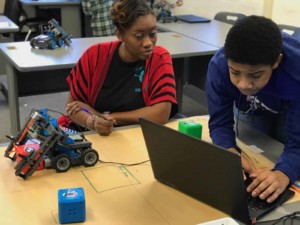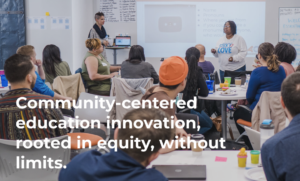Thinking With Your Hands

By: Cate Heroman
Sixty-five percent of kids who are entering elementary school today will have jobs that don’t exist yet. That piece of data has stuck with me ever since I heard it. My educator mind went circling for solutions. To me, the answer revolves around creativity, innovation, and imagination. If we give kids tools to be successful learners, then they will be able to solve problems using whatever new technology comes their way. At the Knock Knock Children’s Museum, we encourage kids to learn through play about a variety of topics using modern technology in combination with beloved stories—both old and new. Kids listen to stories every day, so logic comes easily when there are characters, a conflict, and a resolution.
STEAM (science, technology, engineering, art and mathematics) is integrated in every single learning zone throughout the museum, just as it is everywhere in life. For example, in the Art Garden children may be creating squishy circuits with Play-Doh to make things light up or buzz. In the Knock Knock Maker Shop they may be building Scribbling Machines using motors and batteries, and are challenged to create a contraption that moves across the page and leave a mark in its path. And in Go Go Garage, they may be designing cars with LEGOs, testing them on inclined race tracks, and then making adjustments so they can go faster.

As an early childhood consultant, I’ve been working to mesh storytelling with technology. One way we do this is by teaching students as young as three how to program robots and use other tech tools that help them create a narrative. Here are a few ways we’ve integrated storytelling into teaching STEAM topics.
Fairy Tale Tech
If there’s a story behind a concept, kids get it. Young learners are more likely to successfully engage in a new concept if it’s tied into something they are already familiar with. For our “Fairy Tale Tech” experience at the Baton Rouge Mini Maker Faire, children’s favorite fairytale came to life when we invited them to create their own characters using open-ended craft materials and cardboard tubes. They attached their fairytale characters to one of our KIBO robots and we taught them how to program the robot to move, shake, dance, and sing. They could also take their character to a stop-motion animation station, to create a short movie of their story.



At the museum, children and adults were fascinated using the Watercolor Bot. They drew a character or scene with their fingers on the iPad. When done, they sent their image to the Watercolor Bot—an art robot that moves a paint brush to paint their digital artwork onto paper using a set of watercolor paints.
Arts and Engineering with Puppets
Knock Knock also holds puppetry camps where children make a variety of puppets, including marionettes. It takes a lot of engineering and problem-solving to craft them, but children become deeply engaged in exploring motion by moving the strings of the marionette. We also invite local puppetry artists to teach children how to make Muppet-like characters and put on puppet shows, but not ordinary puppet shows. We use green screens to display our story setting. Using technology in congruence with interactive storytelling enriches not only the puppeteer’s experience, but the viewer’s experience.


Interactive Learning with Storyboards
The museum often collaborates with Louisiana State University to introduce children to new technologies. For example, children love exploring the interactive digital storyboards created by Hye Yeon Nam from LSU’s Digital Arts Department. They created special puppets made from gloves that had copper tape on the finger tips. When they’d touch different parts of the scenery on the storyboard, they could record their voice telling a story. When they walked their hands across the board, children could hear the story being played out across the board. They could use their imaginations to re-record new scenarios or endings to the stories. Integrating technology and the exploration of conductive materials with storytelling added a new dimension to a simple storytelling experience.

Bringing Stories Back to the Classroom
When school groups come to the museum and take part in these STEAM and storytelling activities, teachers are inspired to extend the experiences back to the classroom. They’ve seen the activities in action, and we encourage them to integrate STEAM topics into activities they’re already doing.
We investigate how tinkering and making experiences support fundamental STEAM thinking and learning for young children using a wide variety of activities and new tools. Professional development is critical for teachers, especially since many teachers lack confidence in STEAM content areas. The museum offers a full-day session for teachers on making and tinkering. Our goal is to help teachers embrace a mindset for making and tinkering through engaging, playful hands-on experiences. And, we show teachers how to integrate making and tinkering experiences into literacy and their existing curriculum.
As children think with their hands and represent their thinking through the arts, they can make sense of science, technology and engineering. When we add characters and a plot into their work, it becomes personal and meaningful for each child.
For more, see:
- How STEAM Education Benefits Students At a Young Age
- Building a Kinder World: How Maker Education Can Solve Problems and Foster Empathy
- Arts-Integration for the Future of STEAM Learning
Cate Heroman, a former teacher and state early childhood/elementary administrator, retired from Teaching Strategies in 2012. She’s the author of Making and Tinkering with STEM: Solving Design Challenges for Young Children, and volunteers as education chair and past board chair for the Knock Knock Children’s Museum in Baton Rouge, Louisiana.
Stay in-the-know with innovations in learning by signing up for the weekly Smart Update.







0 Comments
Leave a Comment
Your email address will not be published. All fields are required.